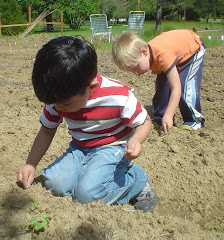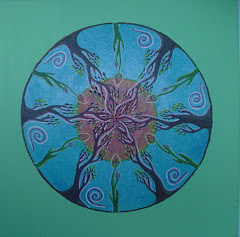 |
| Healthy pea seedlings. |
Garden tips for Peas:
In our region (Zone 8a -
USDA Hardiness Map),
its ideal to plant peas around Valentine's Day. This
gives them the best head start for blooming in time for the longest
possible harvest season. The problem is that, here in Alpine/Monroe,
Oregon, the soil is often very wet
and cold this time of year and, even if you get a good start sowing
seeds directly in the
soil, the March and April rains can significantly retard their growth,
the seedlings can rot off at soil-level, or slugs can decimate your
starts.
If you have raised beds, direct sowing shouldn't be an issue but if,
like us, you don't have that luxury, here's a method we've used
successfully for several years to deal with these challenges:
You'll need:
- Seeds (link to article on saving your own pea-seeds)
- Soil
- 4" pots (6" deep) - the deeper pots give more time before plants become root-bound.
Fill pots to within a half-inch of the top. Gently tamp down soil so it doesn't settle too far when you water it.
Poke two seeds, in opposite corners, about the depth of one knuckle
(3/4" or so).
That's two seeds per pot. This gives each plant enough soil to
germinate and grow to
several inches in height before you transplant. Cover the seeds with
soil so they're not exposed to sun. Water them gently. Do not
over-water. Seedlings can rot if soil is too damp.
 |
| Note: Since having written this article, we have now shifted to planting two seeds per pot but do not have photos to reflect this. |
If you're planting earlier than mid-February, you'll need a greenhouse to protect them
and keep soil in pots warm enough for germination. If you wait until
mid-February, pots can often be outside in a sunny place, protected from north
winds.
When they are
at least
6", and no longer than 12", you can put them in your garden, or greenhouse beds. Best to
wait until their root-systems are quite dense in the pots -- almost
"root-bound". They will be easier to transplant without damaging the
plants. On the other-hand, if you wait until the stems are too long, you
risk breaking stems during transplanting so it's a matter of finding
the right balance.
 |
| Pea-seedlings in pots. |
Transplanting: Plant each 4" pot (with its two seedlings) about 8"- 10" apart with bamboo stakes or
other climbing trellis in between each clump of starts. Pea-plants are
not typically transplanted but sowed directly in place. They are very
susceptible to shock so be gentle with the roots and stems. Best to have
your trellis in place
before you transplant so you don't injure
roots driving in the stakes. If slugs, bunnies or birds are a big issue in your area (they all love to nibble pea-seedlings!),
planting them in the milk-carton collars can make a big difference
(Link to post on Re-Purposing Things - including milk-cartons as collars). We
also typically sprinkle about a teaspoon of iron-phosphate ("Sluggo")
around each bunch of plants. This is an organically-approved way of
dealing with slug/snail infestations in your garden.
(LINK to article about iron phosphate).
 |
| Good idea to have trellis in place before you transplant peas (so you're less likely to damage roots). |
The plants will
go through a little stress from transplanting but once they acclimatize
to their new environment they'll be well along the way to yielding a
bounteous and long-term harvest!
 |
| Chris and Jesse transplanting in the Alpine Garden - 2010. |
 |
| Pea-vines
headed for the compost pile. Peas, being legumes are able to add
nitrogen to your soil through a symbiotic relationship with organisms
that grow on their roots. This will help improve your soil, particularly
if you leave the roots in the ground when you cut down the "greens" to
add to your compost pile. |
Other relevant posts for early-spring gardening:











































No comments:
Post a Comment